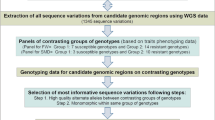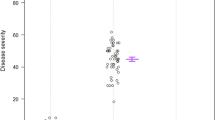Summary
Fusarium wilt (Fusarium udum Butler) is a soil borne disease of pigeonpea which causes substantial yield losses. The disease can occur at any stage of plant development, from the young seedling to the pod filling stage. Though resistance is simply inherited, transfer to locally adapted cultivars has been difficult due to linkage drag and difficulty in accurate phenotyping, except in sick plots. An attempt was made to identify RAPD markers associated with wilt phenotype by using F2 populations derived from contrasting parents; GSl (susceptible) ‘ICPL87119 (resistant) and GS1’ ICP8863 (resistant). Parents and F2s were grown in a national Fusarium sick-plot at Gulbarga, India and phenotyped as resistant or susceptible during the entire crop growth period. In both the crosses, resistance to wilt segregated as a monogenic dominant character. DNA samples extracted from sick plot grown, early seedling stage plants of parents and 254 F2 plants of GS1 × ICPL87119 were held separately for marker identification. PCR reactions using 340 random decamer primers with genomic DNA of parents resulted in detection of 45 polymorphic amplicons from 39 primers. PCR testing of bulked DNA from subsets of resistant and susceptible plants revealed the presence of two amplicons at 704 bp and 500 bp (OPM03704 and OPAC11500) with susceptibility. Analysis of individual F2 plants showed a segregation ratio of 3: 1 for the presence: absence of the amplicon in both crosses. Considering the wilt reaction and susceptibility-linked RAPD marker, it was possible to deduce genotype of every F2 plant and the genotypic ratio for wilt reaction was 1RR: 2Rr: 1rr, as expected.
Similar content being viewed by others
References
Anonymous, 1946. Scientific report, Indian Agricultural Research Institute, pp. 109.
Butler, E.J. 1906. The wilt disease of pigeonpea and pepper. Agril J India 1: 25–26.
Joshi, A.R. 1957. Genetics of resistance to disease and pests. Indian J Genet Plant Breed 17: 305–317.
Jain, K.C. & M.V. Reddy, 1995. Inheritance of resistance to Fusarium wilt in pigeonpea (Cajanus cajan L.). Indian J Genet Plant Breed 55: 434–437.
Kannaiyan, J., Y.L. Nene, M.V. Reddy, J.G. Ryan & T.N. Raju, 1984. Prevalence of pigeonpea disease and associated crop losses in Asia, Africa and America. Trop Pest Managt 30(1): 62–71.
Michelmore, R.W., I. Paran & R.V. Kesseli, 1991. Identification of markers linked to disease resistance genes by bulked segregant analysis: A rapid method to detect markers in specific genomic regions by using segregating populations. Proc Natl Acad Sci (UAS) 88: 9828–9832.
Mohan, M., S. Nair, A. Bhagwat, T.G. Krishna & M. Yano, 1997. Genome mapping, molecular markers and marker-assisted selection in crop plants. Mol Breed 3: 87–103.
Murray, M.G. & W.F. Thompson, 1986. Rapid isolation of high molecular weight plant DNA. Nucleic Acid Res 8: 4321–4325.
Naqvi, N.I., J.M. Bonman, D.J. Mackill, R.J. Nelson & B.B. Chattoo, 1995. Identification of RAPD markers linked to a major blast resistant gene in rice. Mol Breed 1: 341–348.
Naqvi, N.I. & B.B. Chattoo, 1996. Development of sequence characterized amplicon region (SCAR) based indirect selection method for dominant blast-resistance gene in rice. Genome 39: 26–30.
O'Brien, S.J. 1990. Genetic maps. Cold Spring Harbor Laboratory, Cold Spring Harbor, New York.
Pandey, R.N., S.E. Pawar & C.R. Bhatia, 1996. Inheritance of wilt resistance in pigeonpea. Indian J Genet Plant Breed 56(3): 305–308.
Quint, M., C.M. Dussle, Melchinger & T. Luebberstedt, 2003. Identification of genetically linked RGAs by BAC screening in maize and implications for gene cloning, mapping and MAS. Theor Appl Genet 106: 1171–1177.
Ratnaparkhe, M.B., V.S. Gupta, M.R.V. Murthy & P.K. Ranjekar, 1995. Genetic fingerprinting of pigeonpea (Cajanus cajan (L.) Millsp.) and its wild relatives using RAPD markers. Theo Appl Genet 91(6–7): 893–898.
Reddy, M.V., S.B. Raju, S.B. Sharma, Y.L. Nene & D. McDonald, 1993. Fusarium wilt, In: Handbook of pigeonpea diseases. Information bulletin no. 42, ICRISTA, Hyderabad, India.
Sambrook, J., E.F. Fritsch & T. Maniatis, 1989. Molecular cloning: a laboratory manual, 2nd edn. New York, Cold Spring Harbor Laboratory Press.
Sandhu, S.S., C. Colombo, C.R. Bastos & W.J. Siqueira, 2003. DNA tagging of blast resistant gene(s) in three Brazilian rice cultivars. Genet Mol Biol 26: 473–476.
Shaw, F.L.F., 1936. Studies in Indian pulses: the inheritance of morphological characters and of wilt resistance in arhar (Cajanus indicus Spreng). Indian J Agrl Sci 6: 139–187.
Singh, I.P., Vishwa Dhar, Chaudhary, R.C. & D.K. Pandey, 1998. Genetic of Fusarium wilt resistance in pigeonpea. In: National Symposium on Management of Biotic and Abiotic Stresses in Pulse Crops, 26–28th June 1998, IIPR, Kanpur, pp. 15.
Tyagi, A.P. 1997. Investigation of quantitative trait loci (QTLs) in two diverse strains of pigeonpea (Cajanus cajan (L.) Millsp.) using RAPD markers. J South Pacific Agri 4(1–2): 92–98.
Williams, J.G.K., J.A. Rafalski & S.V. Tingey, 1993. Genetic analysis using RAPD markers. Method Enzymol 218: 704–740.
Zhang, Y. & J.R. Stommel, 2001. Development of SCAR and CAPS markers linked to the Beta gene in tomato. Crop Sci 41: 1602–1608.
Author information
Authors and Affiliations
Corresponding author
Rights and permissions
About this article
Cite this article
Kotresh, H., Fakrudin, B., Punnuri, S.M. et al. Identification of two RAPD markers genetically linked to a recessive allele of a Fusarium wilt resistance gene in pigeonpea (Cajanus cajan L. Millsp.). Euphytica 149, 113–120 (2006). https://doi.org/10.1007/s10681-005-9059-2
Received:
Accepted:
Published:
Issue Date:
DOI: https://doi.org/10.1007/s10681-005-9059-2




